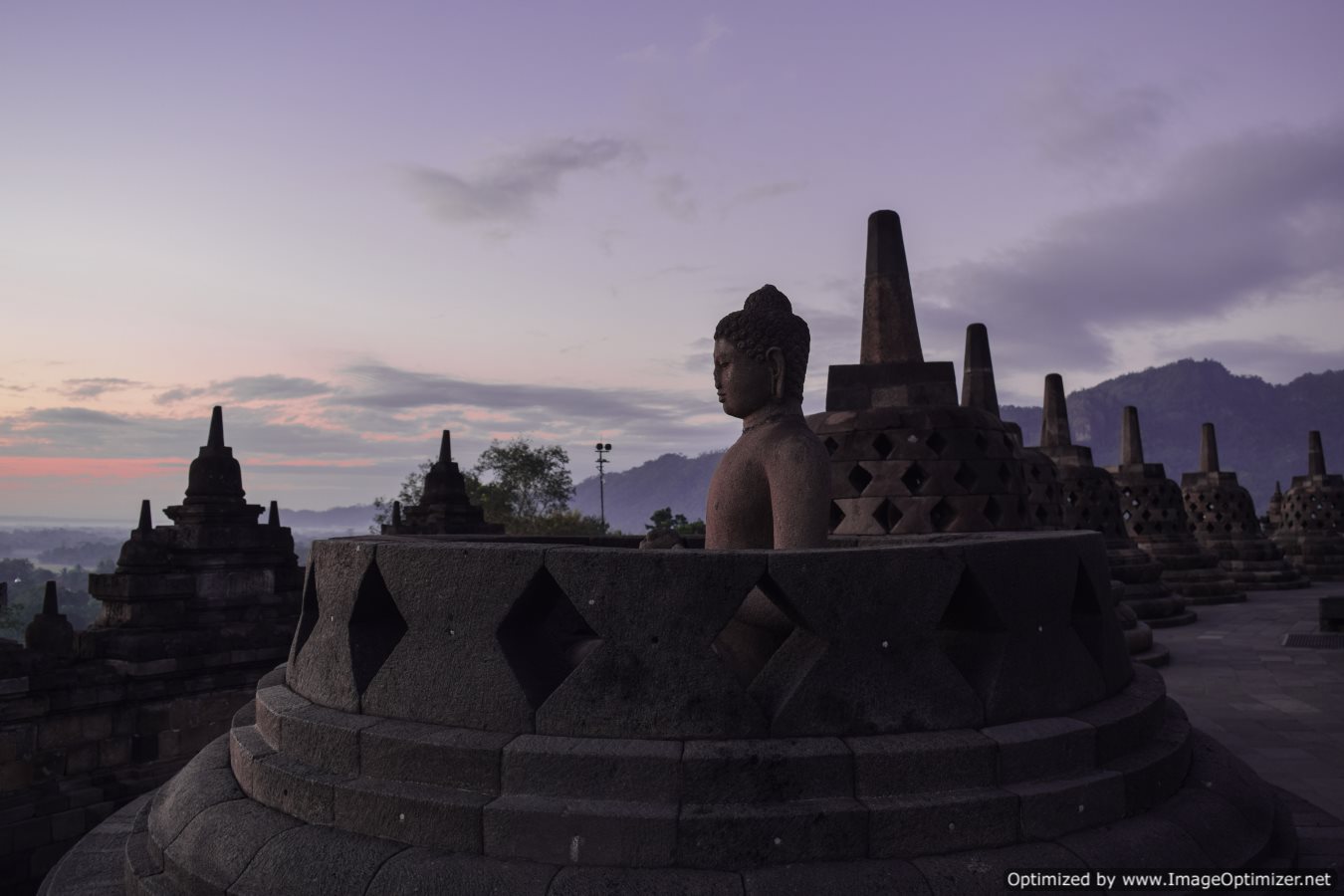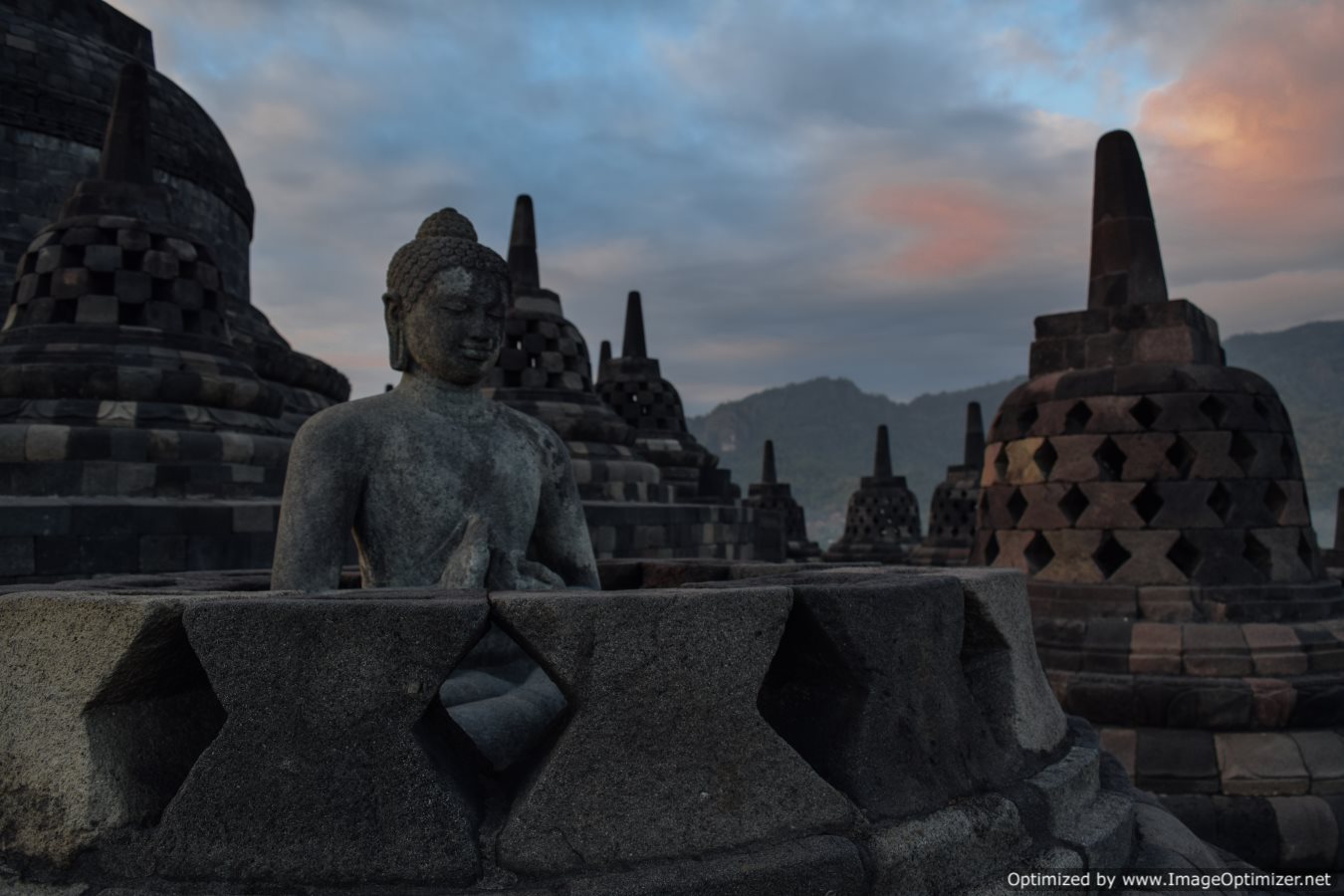
Buddhist temple Borobodur, a UNESCO Heritage site in Yogyakarta
An ancient city and the last remaining Sultanate of Indonesia, YogyaKarta has long nurtured the Javanese connection with the outer world and has been a cradle of art and culture. Old ways of life exist in Yogyakarta, side by side with bustling modernity and the city decorates itself with the symbols of traditions of Buddhism, Hinduism and Islam. From all night shadow puppetry, the age old extraordinary Buddhist temples of BoroBodur and the equally impressive Hindu ones of Prambanan, socially aware graffiti on the wall to the beautifully styled Batik designs; Yogyakarta, Indonesia’s second most visited spot, is a cultural palette on display.
The city comes as a huge relief from the urbane madness of Jakarta, narrow roads lined with trees, old buildings wearing a colonial touch, shops styled as pagodas, slow life, frequent smiles by strangers, alleys lined with themed restaurants, art cafes often buzzing with some performances, random music bands performing on streets and endless boards advertising batik designing lessons; Yogyakarta gives you a feeling of being in a different era.

Prambanan Temple, one of UNESCO Heritage sites in Yogyakarta (pic as appeared in HuffPost)
Yogyakarta is always throbbing with performances. An art gallery hosting a dance troupe visiting the city performing an ancient myth, puppetry shows around the Sultan’s palace, rappers set up on a plaza in the night market, some impromptu performance in some restaurant or coffee shop or even private homes inviting strangers for a local gamelan performance; festivals can pop up from any corner. A cup of coffee in a rather unknown coffee shop can turn into an audience of an upcoming music band. Yogyakarta is always teaming with art and artists. It is a city of choreographers, musicians, filmmakers, puppeteers and rappers going beyond the boundaries through their work and convictions. Most of these performances remain unannounced, uncaptured in art maps, and unscheduled; these are mostly impromptu, not fixing in your vacation calendar. Most hotels will tell you about static attractions. But for real flavor of Jogja, depend on word of mouth and pencil in some time to soak yourself in things the city prides in. Weekends are easily the best time to acquaint yourself with these quaint streets which bubble with art and music and the old town is the best place to start with.

An artists making puppets in a random corner of the city
And as you remain in the lookout for the art scenes, don’t miss to do what all travel blogs tell you. Jogja is UNESCO heritage site for its old temples and its old age puppetry tradition. Put these in your ‘must-do’ list and then proceed. Start off your day with the Krotan Palace, snaking your way through the alleys of old town, an area completely owned by the Sultan. The palace stands like a happy collision between the conformist and the iconoclastic. It is the cradle of cultures that have steeped deep into Jogja’s life and rhythm and it’s never too hard to come across some puppetry show, mask dance or traditional Gamelan music as you walk through its performance pavilions or in some familiar vicinity. Perhaps the most captivating, the Gamelan music, an ensemble of bronze percussion instruments including gongs, xylophones and drums often combined with string and wind instruments as well as vocals, can be experienced regularly throughout the week.

The water castle is at a stone throw away distance from the Krotan Palace

The Krotan Palace is probably the best place to be an audience to a Gamelan performance
At a stone throw away distance is the water castle and at a walkable distance from there, through the narrow alleys, housing some painters, designers and artists is the underground masque. These narrow alleys are more like labyrinthine, guarding some finer cultural souvenirs of the city. This is the place to ditch your bike or cab, and take to foot, as every corner has a story to tell in this old town, every turn is donned with an artsy restaurant or an art café to enthrall the vexed mind. All you need is to show up at right places, and there are plenty of them in this old town (Kota Gede), and you can always expect an invitation to somewhere artsy for something out of your lanes of imagination. Not far from the Kraton is a restaurant built in the traditional Javanese style known as Bale Raos, which serves some tradition Javanese cuisines, some of Sultan’s favourites.
And now that you are in Kota Gede, do some more wandering. The not so faint hearted can take a detour to the nearby bird market, may not be a very exotic touristy hop, but good to peep into Indonesian culture and their passion for birds. Infact it won’t be difficult to find birds (albeit in cages) in homes in Jogja. The more culture aficionados can turn to filigree silver jewelry work in the narrow alleys down the old mosque. Mind some alleys are so narrow that you can stretch your hands and let your fingers graze on the walls (often graffiti-ed). Or head for a leisurely coffee at Omah Dhuwur, a century old restaurant, a colonial heritage, still carrying the whiff of the days long gone by.
Cut to evening and brace yourself for some more artesia. North of the airport stands another emblem of Jogja cultural heritage – the Prambanan temple. The towering temples with spires and spectacularly sculpted walls are a treat to watch. Standing against the backdrop of the ravishing, rich green natural beauty, the always reveling stands of palms, the animated steeply pitched roofs, and the old torn market place; this grandiose structure is always brimming with travelers and photographers from across the globe. Prambanan temple is an example of amalgam of cultures, the Hindu connection of Java, myth and dreams. The temple also serves a backdrop of the Ramayana ballet, a spectacular staging of the South Asian Hindu epic, in a dance drama form, with firelights, extravagant costumes, gamelan orchestra, grandeur and an adroit mastery in story-telling. The town seems to have grown up with the Ramayana tales, no wonder many kids (including Muslim kids) have been named after characters of Ramayana. (The dance performance narrates the story of the abduction of Goddess Sita by demon Ravana and her rescue by Lord Rama with the help of monkey god Hanuman and his army).

The Javanese Ramayana gives a peep into how elegantly Yogyakarta embraced and nurtured different cultures and religious ideals

Scene where Ram crosses the sea to reach Lanka_Javanese Ramayana_Yogyakarta

The town seems to have grown up with the Ramayana tales, no wonder many kids (including Muslim kids) have been named after characters of Hindu epic Ramayana.
The Borobodur Temple
Ditch that urge to lie in late and take an hour long drive past the enchanting countryside to the Borobodur temple, largest Buddhist temple, excavated in the early 19th century by the then British Raja of Indonesia, Sir Thomas Stamford Raffles. Sitting atop a hill, surrounded by volcanoes, Borobodur is a personification of deep spirituality and striking architectural beauty. Be there in the morning to watch the Sun rising from behind the volcanic hills and the first rays creating an inviting silhouette on the Buddha statue. The experience will linger with you for long. Climbing up is a pilgrimage in itself. A colossal 30 meter high step pyramid, housing some 500 Buddha sculptures perched around and lower terraces built as balustrades with countless sculptures from Buddha’s life and teachings, the temple is a sight to behold. And as you climb you are guided by these relief sculptures from one level of consciousness to the other, the highest being the ultimate level of self-actualization.

Mt. Marapi as seen in the morning from Borobodur Temple
In the early 19th century, Sir Thomas Stamford Raffles, British governor of Java, heard of the site and ordered its excavation. Borobodur was in a decayed shape then, a long restoration and reassemblage work has resulted in the present form. During this an extensive drainage system was developed, lower terraces were dismantled and then restored, stones reassembled, sculptures restored and bases strengthened. Even though one can find enough cues of this decay in the temple, Borobodur stands as a defining architectural piece and attracts hundreds of travelers and art lovers from across the world, for academic revelations and picture perfect moments.


Both Prambanan and Borobodur, give a peep into how elegantly Yogyakarta embraced and nurtured different cultures and religious ideals, which still live in the daily rituals of the common folk in the form of rituals, myths, stories passed on from one generation to other, puppetry shows, music, dance forms or just as symbols hung on doorsteps. Reality is that, this is the cauldron where history is lived everyday, where cultures merge and reappear as smiles and perfect wrinkles around eyes, this is where people not guide you but take you to art exhibitions and music shows and random people of this artsy city do their bit to make you feel privileged.

Bells in Borobodur stand as emblems of peace and creativity, the two things Yogyakarta is synonymous of.




Everything looks AMAZING such good tips too 🙂
Thanks, pleased to know you liked it.
nice post